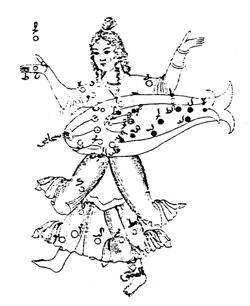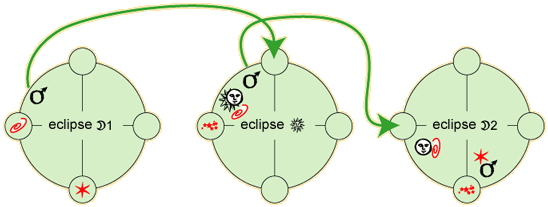|
Marco Fumagalli - The earthquake of western Sichuan
|
|||||||||||||||||||||||||||||||||||||||||||||
|
The eclipses preceding the earthquake
|
|||||||||||||||||||||||||||||||||||||||||||||
Eclipse If we compare the relative positions of the three superiors in these eclipses [18], we notice first that Jupiter is still the only planet to testify the eclipsed luminary, through a square. Moreover, in the first two figures, Jupiter and Saturn are linked by trine (strictly exact in the solar eclipse), while in the last one they square each other, Saturn being opposed to the Moon, while the other two, in opposition to each other, observe it through a square. By considering also the fact that the two malefics are located in the angles, the progressive worsening of the figures turns out to be evident. THE THREE SUPERIOR PLANETS IN THE ECLIPSES PRECEDING THE EARTHQUAKE
At this point, we can trace a first general frame. The eclipses that have been examined highlight five well determinate elements:
The following figure shows the dynamics of these elements in the three eclipses: Mars connects the first eclipse to the second one and the second one to the third one, by means of the passage of its own degree on an angle, which occurs twice. Finally, in the last figure, the malefic planet is conjuncting Aldebaran, a star which was angular at the IC in the first eclipse.
3. Diagram of the reminders in the three eclipses preceding the earthquake By observing the complete figures, which will be found in the appendix, we further notice two wide zones with a concentration of elements in a space of 30° each. These two zones correspond to two northern terrestrial images [19], the Lion and the Bull (Leo and Taurus):
[10] At its setting, the Moon is still completely eclipsed and its going out of the shadow is not visible from Chengdu. According to Ptolemy (Tetr. 2.6), if the eclipse is setting, we can expect its effect after about a year. In this case the correspondence is correct: the earthquake happened in reality about 14 months after the eclipse. [11] I think that we should not exclude the horoscope when looking for the rulership of a figure and, even though most of authors used to consider only the Ptolemaic angle (Tetr. 2.7), they did not agree about which angle to consider: the one which follows the eclipse or the one which precedes it. But the opinion of Kûsyâr ibn Labbân reinforces my own’s: in his introduction to astrology (Madkhal, II.9), the Persian astronomer says indeed that we must always observe the horoscope, in addition of course to the place of the eclipse. [12] The importance of Sirius as a violent star was already obvious in the eclipse preceding the tsunami that hit Indonesia in 2004 (cfr. Breve annotazione sul maremoto del 26 Dicembre 2004, Short note on the tsunami of December 26 2004, in «Phôs» n. 9, p. 28, and also Sirio, Saturno e Marte nell’eclisse lunare precedente il maremoto, Sirius, Saturn and Mars in the lunar eclipse preceding the tsunami, in «Phôs» n. 10, p. 1 ss.). Here we can add that this star, one of the most violent of the sky, is repeatedly cited by Placidus in the examination of the figures relative to the Napolitan rebellion of Masaniello in 1647 (DDD, I, p. 250ss., in Arcana Mundi, p. 570 ss.). [13] The violent and harmful nature of Aldebaran is well spot. We can see, for example, Placidus de Titis, DDD II. 1: «As for the violent disasters, they are provoked, in the judgments of the eclipse, by the harmful stars when both testify the luminaries; and also when, in the place of the eclipse or in the preceding and following angles, we find the most strictly harmful fixed stars, such as Regulus, Antares, Sirius, Procion, Aldebaran, Orion and others». Its declination +16°,52, is opposed that of Sirius, -16°,72, and makes the parallel more dangerous. About Aldebaran as the "heart of the Bull" see the n. 20. [14] The galaxy of Andromeda, today with the abbreviation M31 on the catalog of Messier, is described by the Persian astronomer ‘Abd ar-Rahmân as Sûfî (X sec.) as a "patch of clouds", latha al sahâbî (cfr. H.C.F.C. Schjellerup, Description des étoiles fixes, St. Pétersbourg 1874, p. 118, who translates "small cloud" and specifies that the nebula of Andromeda has remained unknown in Europe until 1612). Its planetary nature did not come to us through the astrological literature, but seems obviously being assigned a very harmful nature, because of its hazy appearance and of its spacious extension. In fact it has been observed in some examples of eye’s affections (the arab word al-sahâb, cloud, has the same root as suhbat, veil, coverage, visual illness) e in altre figure di terremoti. and in other figures of earthquakes. Three examples will be enough: it is at the IC with Saturn in the earthquake of Messina in 1908; it is at the IC in the spring ingress preceding the earthquake of Valparaiso in 1906; it rises with Mars in the solar eclipse preceding the earthquake of Taiwan in 1935. [15] The limit within which I considered significant the "reminder" of an ecliptic degree is three degrees. [16] The Pleiades and Praesepe are connected with the earthquakes in the manuscripts Par. gr. 2424 fo. 75v., and Angelicus 29 fo. 172v, where they appear respectively as "the previous parts of the Bull" and "the initial parts of the Cancer". Both these piled up stars have the nature of the Moon and Mars. [17] When rising, the Moon is already going out of the shadow, but it is still eclipsed for more than 50%. The rising of Andromeda, when the Moon is still under the horizon, corresponds with the last phase of the whole eclipse. [18] Tetr. 2,4: «The method of observation is the following: the first and more powerful cause of such events rests on the ecliptic syzygy of the Sun and the Moon and of the transits of the stars on their respective place […..], as well as the occasional and durable positions of the wandering stars, I mean those of Saturn, of Jupiter and of Mars when they appear stationary, because they give then rise to a significance». This Ptolemaic step is not interpreted, as the astrologers adept of conjunctions would want it to be, as a justification of the importance of the figures between the superior (particularly the conjunctions) in any moment they occur but, as Valentino Nabod observed fairly (Enarratio, diff. IV, p. 355 ss.), only during an eclipse, and above all if the planets are familiar to the luminaries. The station of the superiors in an eclipse is one of the strongest familiarity, and if it happens in the successive figures it becomes one of the most powerful causes of the accomplishment of the events. [19] «From the terrestrial constellations, the northern ones mean most of all sudden earthquakes, the southern ones unexpected pattering of water» (Tetr. 2.7). [20] Regulus does not belong to the selection of the constellations connected with earthquakes, but to the one of the "hearts", that is the more shining stars of some constellations around which the image would have taken shape. One can talk of the "heart" of the Bull (Aldebaran), of the Lion (Regulus), of the Scorpion (Antares), of Sagittarius (Rukbat Alrami). These stars, together with the "tail of the Swan" (Deneb), are considered harmful by the Greek astrologers. |
|||||||||||||||||||||||||||||||||||||||||||||




